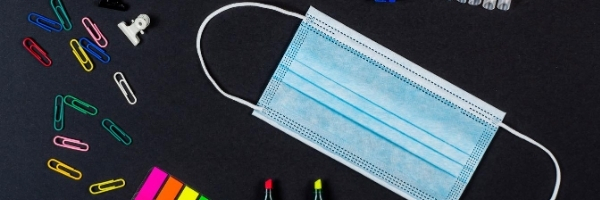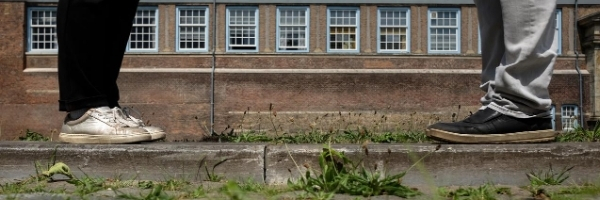Back to school used to mean photos in brand new outfits, pristine backpacks, big smiles, and a rush of triumph as parents shuttled their offspring through yet one more milestone. A new school year means a fresh start in a new classroom, full of possibilities. Who’d ever imagined we’d need a healthy stash of surgical masks as well?
Schools around the world struggle with re-opening in some form or another. Beijing, on the other hand, has clear instructions and perimeters for a successful school year: most can begin classes in person again on Sep 1, only two weeks later than usual. Some schools spaced their start days between grade levels, which means online learning for one to three weeks and a later September start in person.
Every school has a slightly different “new normal,” but the basic factors remain the same, as outlined by the Beijing Municipal Education Commission. Some students experienced this when they returned last spring, but for any child who looks forward to hugging their friends on the first day of school, it may come as a shock. Telling kids the truth is always the best idea, however, and here are a few tips to help mentally prepare students for the new school rules.
Tell Them the “Why” Behind the “How”
It’s been long enough now that we’ve all talked to our kids about the situation. Remind them that returning to school is a real privilege, and only possible because of months of hard work in our communities and by our teachers. Our part to play in keeping Beijing schools healthy is just as important as the work our teachers and healthcare professionals continue to do every day.
It’s important to adjust how much you tell them based on your relationships. Kelly O. from Sanlitun takes a casual approach with her children (Kath, aged 6, and Al, aged 3). “I’m trying to be as cool as possible about it so as not to make my daughter apprehensive. Her school has already introduced awareness about “staying safe” from COVID into her online learning.”
Some kids like to watch videos about germs; others simply need to know that masks and washing hands keep our loved ones safe. Choose the approach that’s best for your family.
Show Visuals of Changes
When schools send visuals of the classroom or entrance procedures, share it with your children. Explain the partitions and one-way stairwells and hallways, and how their job is to follow these instructions to the best of their ability. Temperature checks are always part of our school procedures, so that won’t be a shock. The path they take to the restroom may be different this year, but that’s okay. Let them know they’ll get clear instructions from school personnel and they can ask teachers if they don’t know where to go.
Make a Supplies Checklist
Keep your supplies in a basket at the door or with your keys, backpacks, etc. Make it part of your family ritual and they’ll soon remember on their own.
Angela Kalberg’s 3-year-old son attends daycare and so has already integrated his new supplies into their daily routine. “Before we walk out the door, we check the following: Are there extra masks, hand sanitizer, wet wipes, and tissues? How do we cough and sneeze? He’s pretty good about it and reminds me to do the check,” she told us.
Let your child take charge of their supplies in their backpack so they always know where the extras are. Keep everything in a consistent spot for less confusion. It will require another few minutes before you leave the door, but what an achievement when they know exactly how to find their own spare mask!

Back to school shopping looks a little different this year.
Remind Them to Stay Flexible
The concept of entering your own homeroom, with your own teacher or teachers, and meeting your new classmates who will learn with you the rest of the year: this is how we picture school, especially in primary grades. With the carefully controlled borders, however, not all returning teachers are out of quarantine yet. Some classes will combine hybrid learning and in-person teaching, so teachers are covering for the colleagues who have not yet returned.
For students brand new to a school, it may not seem like a big deal. They don’t know any different. If your child enjoys the knowledge of and routine of homeroom, the transition may be more difficult. Let them know it’s okay to ask questions if they are confused about their teacher or classroom. Schools are trying to make it as seamless as possible for everyone, but there will be hiccups. If kids can stay flexible and ask questions, they’ll know how to cope better and go with the flow.
Practice Ways to Socialize One Meter Apart
One of the biggest challenges this year will likely be the socially distanced schoolyard and lunchtimes. Part of the fun of school is to play with your friends. So how can they have fun if they can’t huddle or play contact games?
There are a number of games you can play from one meter apart: I Spy, Whoosh Ball, Making Shapes, even Hopscotch can be altered a bit to ensure proper distancing. The hardest part will be remembering those distance perimeters while keeping the fun aspect of playtime and socialization.
Mom Roxana Hyskell instructs her three children to “Talk to friends if you see they don’t cooperate with the situation. If you feel the mask all day is getting to be too much, go to the bathroom for a moment, and in a private space take a deep breath and just think: everyone is in this situation. You are not alone.”
She makes a great point, which is to acknowledge that it may be hard sometimes, and that is okay.
Also, this idea that students aren’t there just to follow the rules but also to encourage friends to do so is an excellent way to turn this situation into promoting independence and critical thinking. Sometimes kids just need reminders, and it’s up to all of us to work as a community to help each other stay safe in our learning environments.

Many games require some distance or can be altered to play one meter apart.
KEEP READING: Stay Updated on What’s Been Taking Place at Beijing’s International Schools
Photos: Canva




